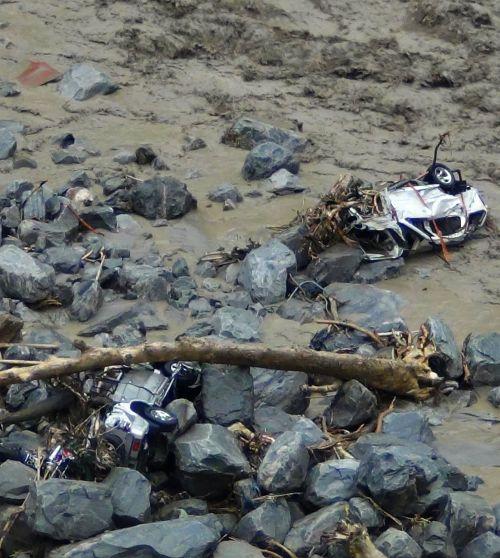
Himanshu Thakkar and Parineeta Dandekar reveal how government actions and neglect created such massive disaster from a natural phenomenon in Uttarakhand.
Uttarakhand is facing a truly humungous, unprecedented tragedy, the full dimensions of which are still not clear. It is feared that thousands could be dead and missing and state could take years to get back to normalcy.
Analysing a natural disaster is a complex and hazardous task. Many a times, a natural disaster and its human impacts are a result of multiple things occurring together. At the same time, disasters, like the one being faced by Uttarakhand currently, highlight the stark anthropogenic reasons which contribute towards causing the disaster as well as increasing its impacts manyfold.
While the calamity is natural in the sense that the region did receive extremely heavy rainfall and cloud burst, the root causes which increased the human tragedy include unchecked and unplanned infrastructure development along the rivers and development of hundreds of hydel projects in the fragile zone without any proper checks and balances, transparent studies and participatory decision-making processes.
Himanshu Thakkar and Parineeta Dandekar are activists of the South Asia Network on Dams, Rivers & People.
Please ..

The first failures:
The first thing that strikes you when you analyse this disaster is that there was no specific and timely warning of impending disaster from the India Meteorological Department or any other body (their claim to the contrary not withstanding).
In fact we do not have a system in place to forecast cloud burst events, when technology is available to achieve that at approximate cost of Rs 15 crore, as I was informed by IMD Director General, Dr S K Srivastava. In this failure, along with IMD, the National Disaster Management Authority and Central Water Commission share the blame. It is good that NDMA vice-chair is now holding meetings to put such a system in place, but had he done that before the disaster, the destruction could have been significantly reduced.
Secondly, even after rainfall started, till date, six days after the event started on June 15, there is no account of how much rainfall occurred at what specific locations, and what was done to alert the populations that were at risk. This is again a failure of IMD and local administration.
In fact Kedarnath, one of the most affected areas, has no rain gauge, says the Indian Express. In the whole of Rudraprayag district where Kedarnath is situated, there is just one rain gauge at the district headquarter, it reported.
This shows how agencies like IMD, CWC, NDMA and SDMA have failed to put in place basic systems of warning, forecasting, monitoring and information dissemination that can greatly reduce disaster potential of any area.
In a state like Uttarakhand, which is prone to disasters like cloud bursts, flash floods, land slides, the indiscriminate building of hundreds of hydropower projects, each project entailing dam, massive underground tunnels that need to be blasted through, the roads, townships and deforestation, the disaster and damage potential goes up multi fold, particularly when there are no credible environment of social impact assessments at project or basin level, no credible compliance system in place, nor any carrying capacity study.
Even the wrong operation of projects can add to the disaster potential, as happened in case of Tehri in September 2010.
Too many hydropower projects, underground tunnels, roads, encroachments of riverbeds by buildings coupled with deforestation have worsened the impact of the flash floods manifold. These are places where there is a heavy tourist influx.
The collapse of buildings like a set of playing cards next to the river shows these were encroachments on the riverbed and floodplains. The river needs path to flow and when it takes the path it needs, the disaster for these buildings was inevitable.
There have been seven similar flood-related disasters in Rudraprayag in the last 34 years. The administration should have learnt, this is not the first time such a disaster has hit us.
Both Uttarkashi and the Chamoli-Rudraprayag-Kedarnath area faced monsoon disasters last year in August-September 2012, killing several people.
Please ...
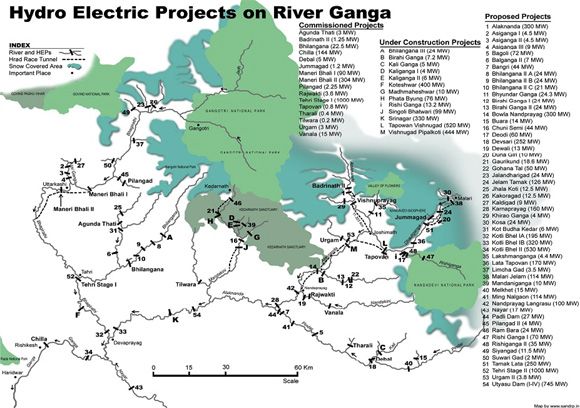
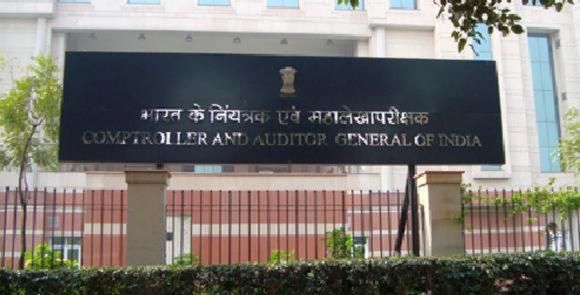
Impacts of dams on environment, hydrology, communities:
Numerous organisations, including CAG has been raising questions about the impact of unbridled hydel power development in Uttarakhand. Their concerns have gone largely unaddressed till now.
In 2009, CAG performed an audit of hydel projects in Uttarakhand and concluded that: "Audit scrutiny of project records revealed that no specific measures had been planned/ designed in any project to cope with the risk of flash floods. The adverse consequences of such floods are acute as they can not only damage the project structures but can cause loss of live in low-lying down stream areas. Civil construction in projects is required to factor in this natural threat. Also the bigger the project, the greater should be the efficacy of the preventive measures."
"Given the current policy of the state government of pursuing hydro-power projects indiscriminately, the potential cumulative effect of multiple run-of-river power projects can turn out to be environmentally damaging.[Paragraph 5.3.2]"
"Negligence of environmental concerns was obvious as the muck generated from excavation and construction activities was being openly dumped into the rivers contributing to increase in the turbidity of water. The projects seemed oblivious of the gross negligence of environmental concerns"
"The plantation activity was highly deficient, as 38 per cent of projects reported hardly any plantation; posing severe hazards both for natural ecology and stabilization of hill slopes"
"Audit analysis revealed that, negligence in applying appropriate construction norms and structuring the project without appropriate technical counter measures may expose projects to enhanced seismic vulnerability"
"In conclusion, the above also shows inadequate construction practices being followed by project developers who failed to cater for such eventualities which are common place in the region. Additionally, it also highlights the ineffective monitoring by the GoU and the nodal agency as a result of which the slapdash approach of the project authorities towards project execution has gone on unchecked"
Read CAG's audit report on hydropower in Uttarakhand in 2008-2009 here
CAG report on Uttarakhand Hydro power projects in 2011 again repeats many of these warnings, but none of them were heeded.In April 2013, a CAG report said that Uttarakhand state disaster management authority, which was formed in Oct 2007, has never met till date. Nor has it mandatory "rules, regulations, polices or guidelines", first step for the authority to have functional existence.
Also See Report
Please ...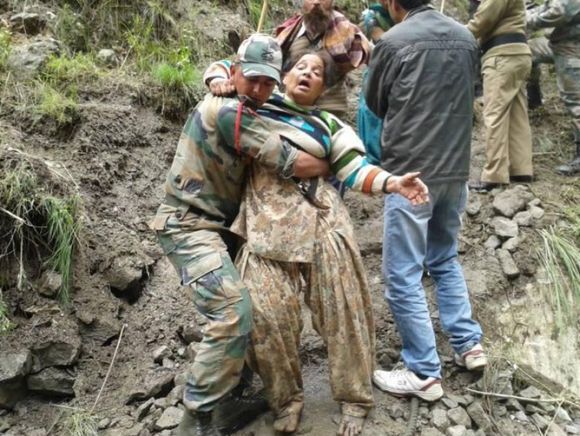
In fact less than a year ago in August 2012, Uttarkashi district saw similar tragedy that left 29 dead, many more missing and collapse of houses like card board boxes, the same scenes that we see now on television news channels.
The Uttarakhand State Disaster Mitigation and Management Centre report of this disaster in October 2012 concluded, "It is therefore highly important to strictly regulate developmental initiatives in close vicinity of streams and rivers. Appropriate legislative interventions would be required for formulating a policy in this regard and firm executive action in accordance with letter and spirit of this policy would be required to ensure compliance of the same."
Nothing was done about this recommendation.
Similarly in September 2012, Okhimath in Rudraprayag district (again one of the epicentres of current tragedy) saw monsoon induced landslides killing 69 people among other damages.
The state DMMC report of this tragedy in October 2012 made a number of recommendations to reduce the risks of landslides in landslide prone state, one of them read, "Use of explosives in the fragile Himalayan terrain for infrastructure developmental works introduces instability in the rocks and therefore use of explosives should necessarily be banned."
And "This provision would automatically ban habitation in the close proximity of seasonal streams and rivers. In case people are already residing in such areas provision has to be made for their timely relocation."
Again nothing was done about these recommendations. In fact Rudraprayag has faced monsoon related major disasters seven times in last 34 years, including in 1979, 1986, 1998, 2001, 2005, 2006 and 2012, each involving death and destruction.
If implemented, these recommendations could have saved many lives. Each of the hydropower project in the state involves massive blasting, but there is no regulation in place about this even after clear warning from state DMMC.
Please ...
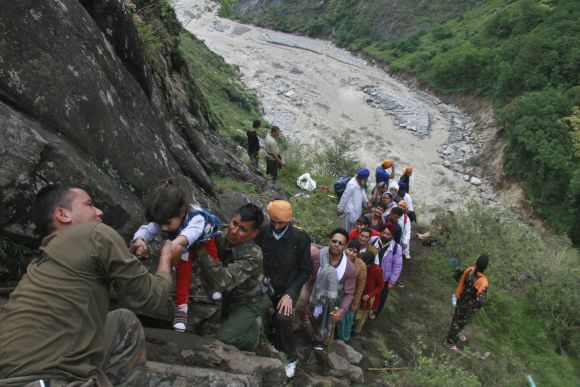
Predicting and controlling disasters transparently and swiftly is a crucial factor. Numerous organisations, groups, individuals, even government institutions have raised the issue of impacts of cascade hydel dams on Upper Ganga on hydrology, ecology and communities in this fragile region. Most of the suggestions have been ignored. Such projects should not be taken without the credible studies as mentions above and those under construction should be reviewed.
Even gazette notification of 135 kms of Bhagirathi as an eco-sensitive zone came in pretty late from the MoEF and is being opposed by both Congress and BJP, clearly showing political nexus with hydropower and building lobby.
The responsibility for the numerous failures in the current disaster rest on many institutions, including: Uttarakhand government and its disaster management unit, IMD, Union water resources ministry and Central Water Commission, ministry of environment and forests and its expert appraisal committee on river valley projects, and the prime minister, who is the chairperson of the National Ganga River Basin Authority and National Disaster Management Authority, among others.
Incidentally, the MoEF has been sitting on draft river regulation zone notification for more than three years now. The RRZ Notification could have helped in controlling infrastructure development like hotels and homes along the river.
At the cost of hundreds or possibly several thousands of lives, the current disaster can provide some lessons. The contributing reasons like indiscriminate building of hydro projects, dams, tunneling, blasting, mining, roads, hotels and townships are accepted by all concerned. The topographical, seismological, geological fragility of the region is well known.
Climate change is no longer a distant, obscure event, it is in front of us now. The fact that the Uttarakhand state is prone to numerous disasters including cloud bursts, flash floods, landslides, erosion, and earthquakes has to be kept in mind while reviewing current and future infrastructure.
Immediately we need to put in place system for warning and forecasting for cloud burst and flash floods, systems of prompt dissemination of information to the concerned administration and local people. Put in place credible monitoring of rainfall that will also provide warning to the affected area.
Activate the state Disaster Management Authority and ensure that necessary structure, rules, regulations, policies and guidelines are in place. Ensure that there is proper place for SDMA in decision making process of all development related ministries. Implement past recommendations of the DMMC like the ones mentioned above. Similarly NDMA should have a role in development decision making at the centre as there is complete disconnect between what NDMA is saying and what environment, water resources, power and other ministries are doing.
Ensure that flow paths and space for river, or river beds and flood plains are clearly demarcated and regulation zones are put in place to protect them. Ensure that all buildings at risk in such zones are removed in time bound manner on urgent basis.
In keeping with all these factors, there is an urgent need to immediately stop the ongoing hydel projects in Uttarakhand and review the same, address pending issues raised by the current disaster, undertake credible carrying capacity study of the region, scrap 24 projects mentioned by WII, considering geological impacts, monitor commissioned projects closely for compliance, decommission commissioned projects which flout environmental norms or have a severe downstream impact, manage 135 kms eco-sensitive zone on Bhagirathi, have a similar one for Alaknanda and near all river origins in Uttarakhand, drop all ongoing and future projects & decommission existing projects on six tributaries that IMG has said should be left in pristine state.
These are absolute minimum steps we need to take if we have any concern for the future of Uttarakhand and its people.
...